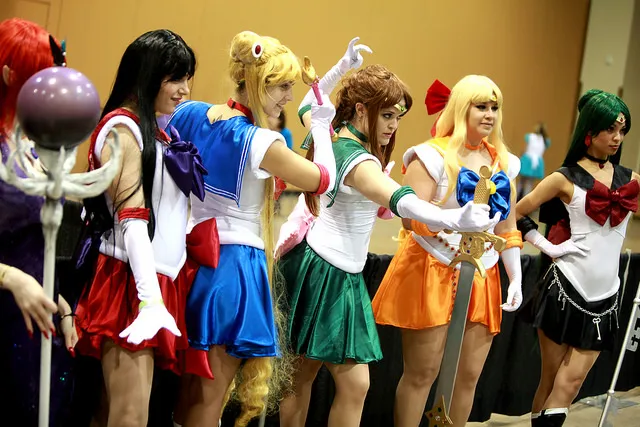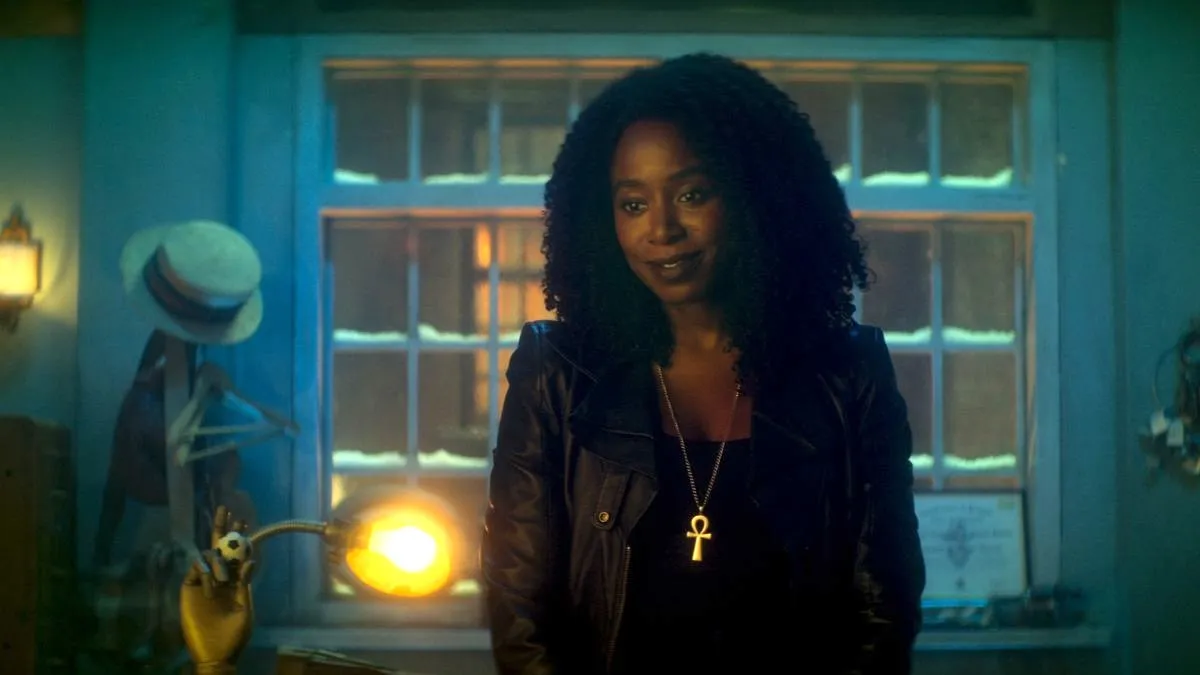Today you can’t go pretty much three virtual feet on the Internet without running into something Sailor Moon related, but people didn’t just start churning out fanart and crossover cosplays overnight. It takes time to build a fandom, and the sailor-suited soldier of love and justice has had something like 20 years to grow and evolve–alongside the Internet itself, in fact. Let’s celebrate it together, friends.
Just like with last week, I’m the most familiar with English-speaking examples of online fandom, so that’s the lens through which I’ll be writing for the most part. And I know I am going to miss stuff, because fandom is a very huge thing and it’s tough to get a handle on (like, I know nothing about the infamous Otaku Wars, for example), which is why this week’s post is less chronological in nature and instead organized a little bit more by topic. If you’ve got stories about your own experiences with fandom, whether they be in a different language or not, then be sure to let us know in the comments!
Also, I’ve deliberately chosen not to write at length about any particularly-negative controversies within the fandom, particularly those that would single out any individual fan–sub vs. dub arguments, for example. We’re all Sailor Moon fans here, so let’s try to keep it civil, k?
The Early Years of American Fandom
These dern kids with their OT8’s and their head-mounted cannons sometimes act like they invented fandom (I’m being facetious, of course–I just wanted you all to have the same dorky mental image of head-cannons that I do), but many of us know that the practice of interacting and identifying with a media property is a time-honored tradition that goes as far back as Sherlock Holmes. Thanks to the magic of the Internet, however, fandom is more intense and better connected with itself than ever, for better or worse. But when Sailor Moon was first being aired in the early ’90s, the Internet was not the social networking powerhouse that it is now, which made for a wild and exciting time. Usenet groups, mailing lists, and chatrooms were big well into the early ’00s before they got overtaken by forums, which in turn got swallowed up by social blogging platforms like Livejournal and, later, Tumblr.
Like many of us, I was only a child in the ’90s and didn’t quite catch up with the fandom until around the time that the Cloverway dub began airing. While at a friend’s house somewhere around 2001, I happened to catch a rerun of the final episode of S, thought “who the hell is that pink kid,” and raced to the Internet the second I got home. There I found a whole new world of webrings, character shrines–I later joined in and created my own geocities page about Sailor Saturn– poorly translated Japanese, pirated game ROMs, role-play communities, and occasionally porn when I wasn’t expecting it. It was one of my first and most poignant memories of the Internet, and I still have very fond memories of it today. (Except for the porn, of course. That was actually kind of upsetting.)
If you’ll remember from last week’s North American dub history, DiC originally stopped its production of English-translated version about halfway into Sailor Moon R after 65 episodes, which happened to be right in the middle of a cliffhanger. This, naturally, angered a great many fans of the show, who used their fandom communities to commiserate with one another. One of the first and biggest campaigns to bring the Sailor Moon dub back was put together by a website called S.O.S., or Save Our Sailors. The makers of this website (which still exists today— that Slayers odango at the bottom of the page has haunted me for years) organized petitions and “procotts,” which involved inciting fans to buy the products of a company who had sponsored the initial series run.
Although it was a viable resource for impressionable young Moonies who were only just learning that their favorite show had a deeper and more complicated history than they could have imagined (cough), the site had its fair share of problems. In particular it was responsible for propagating a lot of misinformation about the series, most notably a completely fabricated origin story for Sailor Uranus that attempted to explain her relationship with Neptune by suggesting she was once a male prince who’d been reincarnated into a senshi. The story was taken down once it had been confirmed to be false, but the damage was done to Save our Sailor’s reputation, and it slowly faded into obscurity.
Other fans attempted to take matters into their own hands in between Sailor Moon hiatuses, and began to distribute their own fansubs and dubs of the latter seasons. Such as this one, for example!
The above clip is from a particularly notable American fandub organized by Mark Sprague in 1996. It covered the first four episode of S and was distributed via VHS a few years later.
Most of these mid-series projects were eventually abandoned once Cloverway began to pick up the slack with S and SuperS, but once it was clear that the final season would never make it to American television (not that this stopped many fans from watching pirated versions of the last season even if they didn’t know a word of Japanese), new fandub projects emerged. One of the most well-known of these, Fighter4Luv fandubs, dubbed the first ten episodes of Stars to match the original DiC editing style and were able to complete the Nehelenia revenge arc in its entirety. And since you’re wondering, no–they don’t refer to “Amara” and “Michelle” as cousins. Hooray for progress!
Fans in other countries have also participated in fandubbing as well, not just of the original anime but of the live-action series as well. Somewhere on the Internet, there exists a German-talking animated Luna plushie. Knowing this warms my heart.
And there were other oddities on the Internet to be found too, in those early years. One of my earliest introductions to the fandom was a website called The Chibi Project. Apparently people really hated Chibiusa back in the day because of her pinkness and her antagonistic behavior towards her future-mom Usagi, so the Chibi Project decided to capitalize on that hatred in the best way possible: conducting “scientific experiments” where they subjected a tiny gashopon of Sailor Chibimoon to all kinds of horrific tortures.

From their infamous fire test.
They’ve since moved on to abusing other anime figurines and even producing their own podcasts, but I’ll never forget the initial pseudoscientific glee with which they wrote about launching Chibimoon off the ground with an Estes D12-3 rocket engine.
Fandom in Japan
Of course we can’t forget that Sailor Moon has a ridiculously loyal following in its own country as well, who also expressed that obsession in a lot of different ways. There was a lot more licensed material available to them, of course (and still is– ask me about the Sailor Moon-themed boutique in Tokyo and count how many veins pop in my forehead out of sheer jealousy), but everyone knows that an overabundance of merchandise doesn’t make people stop creating their own, right?
One particularly huge trend in Japan is the practice of creating, selling, and distributing Sailor Moon-themed doujinshi. Speaking generally, the term “doujinshi” refers to any self-published manga by mostly amateur creators. However, in the west it’s colloquially used to denote self-published fanworks, of which there is a lot. These kinds of materials pretty much fly in the face of all copyright laws on the books both in Japan and in the States, but it’s kind of looked at the same way that selling prints of your fanart here is: yeah, it’s technically illegal, but more often than not it’s good for brand recognition and too much of a hassle to clamp down on anyway, so everybody more or less looks the other way. Plus, if you’re really good at it and make a name for yourself, you can possibly get a professional job out of it! Just don’t draw too much terrible porn and you’ll be fine.
Sailor Moon doujinshi, of course, is vast and incredibly varied. There are a large number of famous circles of artists, such as “Studio Canopus” (they do a lot of great Haruka/Michiru yuri work), Pale Lilac (features one of Naoko Takeuchi’s former assistant as an artist), Black Dog, (a loooot of hentai) and Fragrant Olive (mostly Seiya/Usagi stories). These stories tend operate in the same way that your standard fanwork does: they’re usually character driven, tend to take place within the run of the actual series, and are occasionally sexual in nature. Okay, often sexual in nature. But let’s be real, I’m sure you gleaned that from seeing the word “fanwork.”
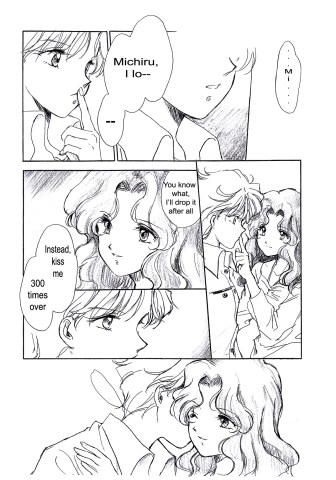
From Studio Canopus’ “March 6.” (translated by fairymascot on Tumblr)
Because these doujinshi are geared towards Japanese audiences and not mass-produced or licensed in the same way that actual manga is, it can be pretty difficult to find people who were willing to scan it and translate it into different languages. Miss Dream and Three Lights are both fairly good resources, the former in particular for scanned translations, but you can also look on eBay for original copies if you know the name of the doujinshi circle. And, of course, there are also people on Tumblr who will translate their own copies if you know where to look!
The biggest place to buy and sell doujinshi is Comiket, a biannual convention that’s been going in since the ’70s and attracted over half a million attendees in the summer of 2013. Many Comiket visitors over the decades have been women, too; they reportedly represented 71 percent of doujinshi-sellers at Comiket over the 30 years leading up to a study done in 2008. However, 2010’s summer Comiket had a breakdown of 60% male attendees to 33% female (with 7% refusing to answer) based on some preliminary research, so it’s possible that the convention may be undergoing a shift.
While it’s not as popular as it once was now that the Sailor Moon toy craze has picked back up, I remember also being fascinated with the Japanese garage or resin kits I saw online as a preteen. You know how your dad liked to build and paint model airplanes in the ’90s? That same hobby is popular in Japan, too, but with models of anime characters. Like doujinshi, they are often not properly licensed and instead put together by third party sculptors, but Sailor Moon remains an especially popular subject for many kits. You want lovingly handpainted 1/6 sculptures of your favorite sailor senshi in her Sera Myu costume? You got it — as long as you’re either willing to either pay through the nose for it on eBay, or paint it yourself.
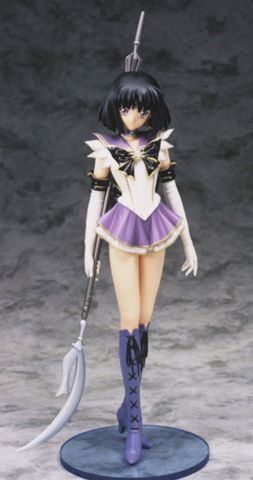
Naturally cosplay is huge as well, just like it is everywhere; while Japan didn’t originate the practice of wearing costumes to conventions, it was a Japanese reporter who coined the term “cosplay” way back in the ’80s, and the hobby has become popular with young women in particular. Comiket is also a huge hub for cosplay these days, too, though you tend to see less interpretative versions of the senshi like you do here and more strictly authentic ones. But cosplay is rad no matter how you do it, of course!
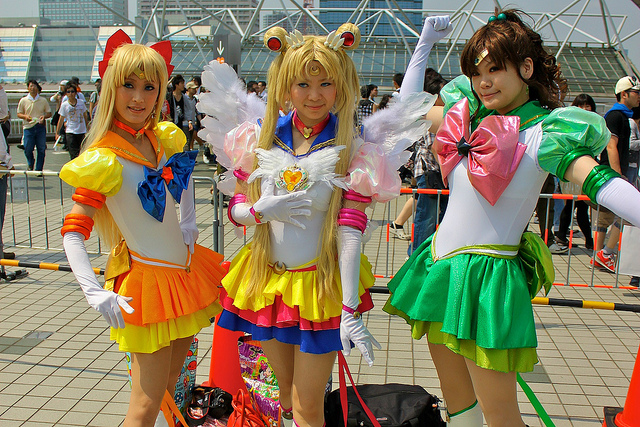
Cosplayers at Comiket 78 in 2010. (via Emil Olsen)
Otaku Senshi
Self-insertion and original characters (OCs) have been popular element of fanfiction and fanworks since the dawn of the first “Mary Sue” (she was a Star Trek fanfiction parody from the ’70s), but they blossomed even more radically in the Sailor Moon Universe, especially after the final arc of the story was released. After all, once you find out that the galaxy is full of Star-Seed carrying senshi, the sky is quite literally the limit.
These fan-created senshi, also sometimes known as “otaku senshi,” generally consist of an image and character profile and often appear in fanworks by their creators, most notably fanart. There are a lot of Sailor Earths and Sailor Suns, of course, as well as some named after constellations (Sailor Orion was a personal favorite of mine), zodiac signs, elements, planets from other science fiction and fantasy properties–anything you could think of. Then there are the Crystal Tokyo children and/or newly reawakened Silver Milennium siblings of already existing senshi. Basically there are no rules to what you can do with an otaku senshi other than what you can imagine, although most fans generally agree that they have to identify as female and they have to have some kind of a sailor collar–though of course those guidelines get broken on a regular basis, too.
Pretty much everybody in the Sailor Moon fandom has tried their hand at creating their own senshi, whether they care to admit it or not. Heck, I totally had one growing up. She was named Sailor Aisuzu (which I think was supposed to mean “Ice Planet”) and she looked something like this, if memory serves:
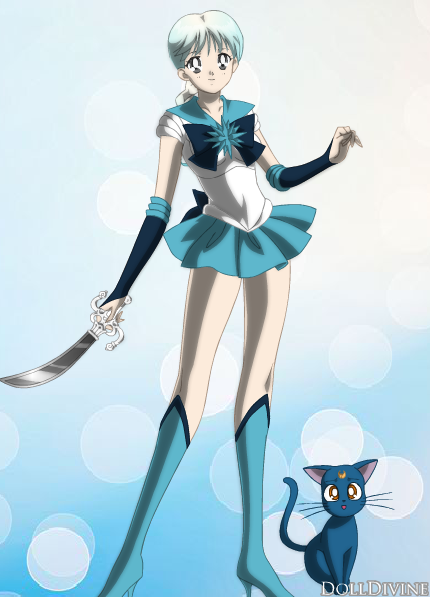
I don’t remember what I named her cat, but I very vividly remember writing stories about the two of them FOR A CREATIVE WRITING CLASS in sixth grade. Nerd girl 4 lyfe.
I basically poured all of my preteen angst into her a character back in the day. She was a loner who worked separately from the other senshi and I think might have had divorced and/or dead parents, even though I didn’t–it just felt like a good way to justify why she was always in the worst mood all the time, because I figured I could offset the dreaded “Mary Sue”-ness of her by making her a jerk who no one liked at first. Also, I designed her for a Dragonball Z/Sailor Moon crossover fic where she fell in love with Future Trunks (and also jumped in front of the blast that kills him during the Cell saga to save his life — guess who really liked the Les Mis musical as a middle schooler?). So no judgment, kids.
For people who aren’t necessarily artistically gifted and don’t feel comfortable drawing their OCs, cute senshi generators exist to help you out. The first dollmakers (Sailor Orion was once again a pioneer in the field, as was Sailor X) were available on a downloadable program called KiSS, which stood for Kisakae Set System and which was more or less the precursor to modern in-browser sites like DollDivine. Nowadays most people use the senshi maker by Drachea Rannak (pictured above), who’s currently working on an updated version which is going to be pretty rad. Many people also commission Drachea to draw their OCs as well. You might remember him from those Disney princess senshi that were going around last year. He does pretty awesome work.
Otaku senshi generally get a bad rap in the same way that all OC characters do, even today; sometimes they’re not particularly well-rounded and maybe aren’t the best characters. But just like how fanfiction teaches budding writers how to hone their craft, creating senshi is a fantastic outlet for character creation, wish fulfillment and empowerment, and artistic expression. Besides, it’s fun! Who doesn’t want to imagine themselves as a butt-kicking soldier or a reanimated princess from another world, surrounded by friends and loved ones who share in your ideals and support you no matter what? That’s part of the reason why we all love Sailor Moon so much in the first place, right?
Modern Fan Projects
Thanks to the magic of the Internet there is a lot going on in the modern Sailor Moon fandom, especially now that the 20th anniversary, the Kodansha manga translations, the new Viz Media anime rerelease, and the Crystal reboot have gotten everyone all excited. Liveblogged commentary on episodes of the series is very popular, as are role-play communities, fan art redesigns, webcomics, and making music videos, sometimes with nothing but construction paper. (that guy’s the best, by the way)
One of the coolest Sailor Moon projects I’ve seen on the Internet is a quiet trend on Tumblr of artists taking a screenshot from the anime and redrawing it into their own style. This phenomenon has since spread to other fandoms and I’m not even totally sure if it originated with Sailor Moon in the first place, but it’s kind of fantastic.
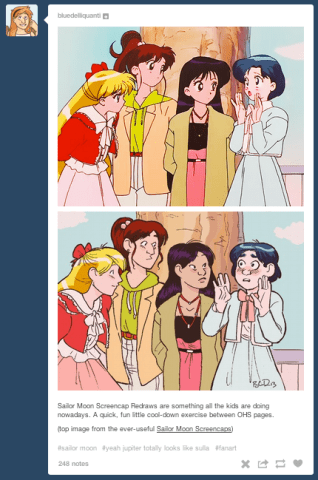
a redraw by Blue Delquanti
The Moon Animate Make-up! project operates similarly, in that it deals primarily with redrawing scenes from the original series. However, this project’s a bit bigger in scope: artists were asked to submit a few seconds of shot-for-shot remade animation (using the dub’s vocal tracks) in their own style, which will be edited together to create a whole crowd-sourced episode. The final product is supposed to come out sometimes in mid July, just in time for the new series.
Moon Animate Make-Up isn’t the first time someone has tried to put together a video tribute to their favorite butt-kicking senshi, of course. There are a number of fan films you can find on the Internet, including the 2011 American-made Sailor Moon: The Movie, or the 2012 Australian Dead Moon Circus two-parter. There’s even a documentary called In the Name of the Moon about a Sailor Moon cosplay group:
To an outsider, watching people dress up as senshi and act out scenes or take pictures with one another probably looks kind of dorky, much in the same way that all fandoms look dorky when you’re not currently entrenched in them. And I don’t know about you, but sometimes it’s surreal thinking about how much of an impact Sailor Moon had on my life, and how much I still think about it on a near constant-basis even when I’m not writing 3000 word articles once a week about it. Seriously, I had Sailor Moon bedsheets growing up. I, a fully grown woman, have dressed up as a cartoon character whose face I once used to sleep on.
When I see people coming together over shared love of this series, though, it’s hard not to get excited about it. Sailor Moon fandom isn’t exactly a perfect utopia and there are arguments and controversies and problems, just like there are whenever you get a big group together who are all interested in something. But Sailor Moon was and has been so important to me, and it’s amazing to see the joy, talent, and camaraderie shared by people all across the world– especially by other women who grew up with the show’s empowering message of believing in yourself and your friends, just like I did.
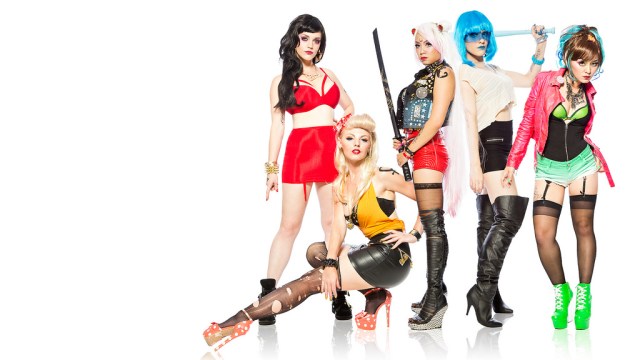
Biker gang cosplay via Michelle Nyugen, inspired by Bab Tarr
- History of Sailor Moon, Part 1
- History of Sailor Moon, Part 2
- Sailor Moon Newbie Recaps, Episodes 1 and 2
Are you following The Mary Sue on Twitter, Facebook, Tumblr, Instagram, & Google +?



